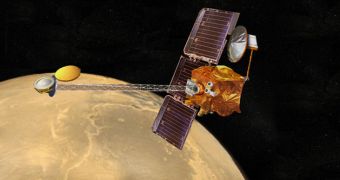Scientists at NASA announce that they will be conducting a final attempt to pick up potential radio signals emitted by the presumably-defunct Phoenix Mars Lander. The spacecraft arrived at the Red Planet in 2008, and mission managers lost contact with it two months after it exceeded its initially-planned mission time. Now, engineers believe that the Mars Odyssey orbiter may be able to catch any potential radio signals that Phoenix may be emitting, assuming that it found sufficient power in its batteries to conduct such a task, and that its radio equipment is still operational.
The machine was not designed from the get-go to endure the harsh conditions of a Martian winter. In addition, it touched down at a very high latitude, near the North Pole, in a bid to find water-ice frozen in Earth-like ice caps. That mission was successfully completed, as the lander managed to identify the stuff as soon as its “feet” sank through the Martian sand. Investigators then directed it to analyze the weather at its location, which it continued to do until power levels dropped to extremely low levels. Phoenix does have an ace up its sleeve, so to speak, namely its Lazarus Mode.
With it, engineers hope to be able to reactivate the spacecraft. Basically, what the Mode does is open up radio communication channels as soon as the lander accumulates enough electricity in its batteries. Given that contacting Earth directly could really drain the batteries, the lander is programmed to try and contact any of the three orbiters currently around the Red Planet. NASA operates Odyssey and the Mars Reconnaissance Orbiter (MRO), whereas the European Space Agency (ESA) has the Mars Express spacecraft ready for relaying any potential Phoenix message.
Chances are, however, fairly low that this will happen. This is the fourth listening campaign that NASA will conduct for the lander. Odyssey already performed three series of flights over the past three months, and none of them picked up on any sign of activity. Still, mission planners at the NASA Jet Propulsion Laboratory (JPL), which managed Phoenix, say that they are willing to give it another go. The new campaign will take place for four days, between 17-21May. “To be thorough, we decided to conduct this final session around the time of the summer solstice, during the best thermal and power conditions for Phoenix,” explains JPL Mars Exploration Program chief telecommunications engineer Chad Edwards.

 14 DAY TRIAL //
14 DAY TRIAL //